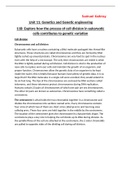Essay
Unit 11: Genetics and Genetic engineering Learning aim B: Explore how the process of cell division in eukaryotic cells contributes to genetic variation
- Course
- Institution
contains all the details needed to get a distinction grade and signposted. D2 Evaluate how the behaviour of the chromosomes leads to variation. M2 Demonstrate skilful preparation of microscopic slides to observe and draw the stages of mitosis and meiosis. B.M3 Discuss the behaviour of the ch...
[Show more]



